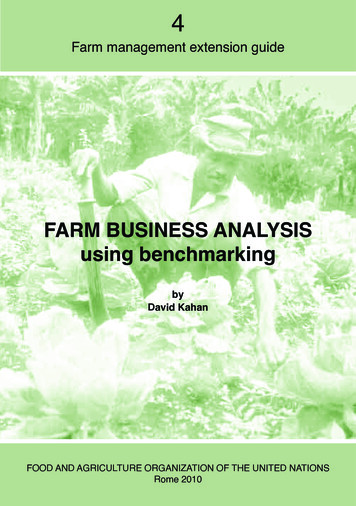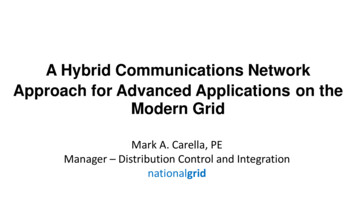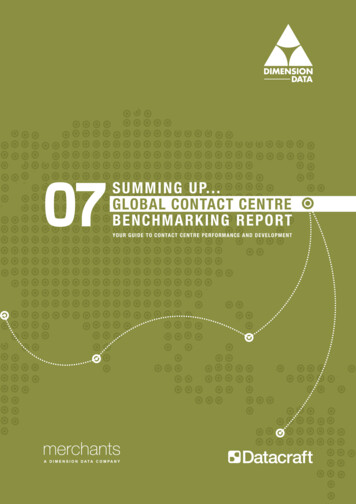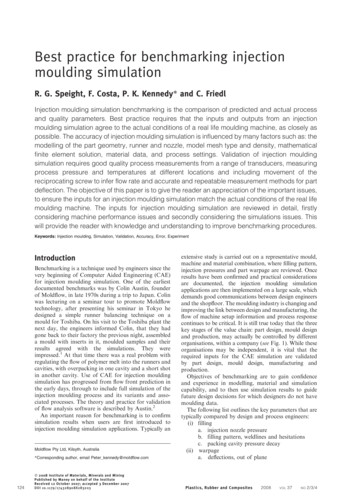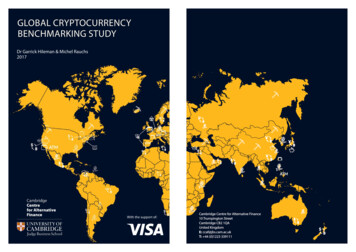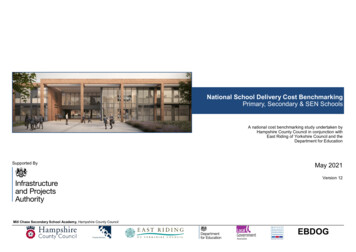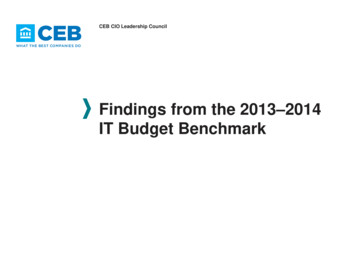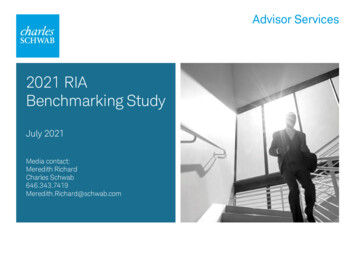
Transcription
International benchmarkingof 900MHz and 1800MHzspectrum valueFinal Report for OfcomSeptember 2013DotEcon Ltd17 Welbeck StreetLondon W1G 9XJwww.dotecon.com
ContentiContent1Introduction12Spectrum award benchmarks32.1Data used32.2Band specific benchmarks132.3CCA cross checks352.4Relative band value413Licence renewal fees453.1Approach to renewal fees473.2Renewal fees504Market value indications from spectrum trades544.1700MHz spectrum trades544.22.1GHz spectrum trades585Conclusions62Annex AAuction benchmarks64Annex BRenewal fee case studies71Annex CFrequency band impact on spectrum value84Annex DPrices using alternative WACC99International benchmarking of 900MHz and 1800MHz spectrum value - September 2013
Tables & FiguresiiTables & FiguresTable 1: Summary of results .viTable 2: Economic, demographic and market data of large European countries and theUS . 10Table 3: 1800MHz Sample Summary Statistics . 25Table 4: 2.1GHz Sample Summary Statistics . 32Table 5: Benchmark values . 34Table 6: Package prices in the Swiss auction . 36Table 7: Package prices in the Romanian auction . 37Table 8: Package prices in the Irish auction . 38Table 9: Package prices in the Dutch auction. 39Table 10: Packages prices in the UK auction . 40Table 11: Packages prices in the Australian auction . 41Table 12: Relative band values within auctions . 42Table 13: Relative band values across auctions within the same country . 43Table 14: Licence renewal terms and charge structure . 47Table 15: Lower and upper bound of spectrum valuations from New Zealand,Australian and the Netherlands (price/MHz/pop for a 20 year term) . 50Table 16: Indicators of spectrum value . 63Table 17: 700MHz auctions . 64Table 18: 800MHz auction . 64Table 19: 800MHz awards . 65Table 20: 900MHz auctions . 65Table 21: 1800MHz auctions . 66Table 22: 2.1GHz auctions. 68Table 23: 2.6GHz auctions. 69Table 24: 2.6GHz awards . 70Table 25: Auctions in other bands used in benchmarking analysis . 70Table 26: Normalised relative cell radii of different frequency bands . 88Table 27: Normalised relative cell area of different frequency bands . 89Table 28: Relative network deployment cost between frequency bands . 93Table 29: 900MHz auctions . 99Table 30: 800MHz auctions . 100Table 31: 800MHz awards . 100Table 32: 700MHz auctions . 101International benchmarking of 900MHz and 1800MHz spectrum value - September 2013
Tables & FiguresiiiTable 33: Sample summary statistics using WACC of 4.10% . 101Table 34: Sample summary statistics using WACC of 8.86% . 101Table 35: 1800MHz auctions 2010 - 2012 . 101Table 36: 1800MHz auctions 2006 – 2009 . 102Table 37: 1800MHz auctions 2001 – 2005 . 102Table 38: 1800MHz auctions 1995 – 2000 . 103Table 39: 2.1GHz summary statistics using WACC of 4.10% . 104Table 40: 2.1GHz summary statistics using WACC of 8.86% . 104Table 41: 2.6GHz auctions . 104Table 42: 2.6GHz awards . 105Table 43: Switzerland . 105Table 44: Romania . 105Table 45: Ireland . 106Table 46: Netherlands . 106Table 47: United Kingdom . 107Table 48: Australia . 107Table 49: Relativities implied within auctions . 108Table 50: Relativities implied within countries . 108Table 51: Renewal fees . 108Table 52: Spectrum trades . 109Figure 1: Licence duration adjustment .6Figure 2: A Box Plot . 12Figure 3: 900MHz auction average price . 14Figure 4: 800MHz auctions . 18Figure 5: 700MHz Auctions . 22Figure 6: 1800MHz Auctions . 24Figure 7: 1800MHz Auctions 2010-2012 . 25Figure 8: 1800MHz Auctions 2006-2009 . 28Figure 9: 1800MHz Auctions 2001-2005 . 29Figure 10: 1800MHz Auctions 1995-2000 . 30Figure 11: 2.1GHz Auctions and Awards . 31Figure 12: 2.6GHz Auctions and Awards . 33Figure 13: Prices paid for 2G authorisation in Western Europe . 46Figure 14: Renewal fees in case study countries (price/MHz/pop for a 20 year term) . 52International benchmarking of 900MHz and 1800MHz spectrum value - September 2013
Tables & FiguresivFigure 15: 700MHz spectrum trades . 56Figure 16: Cisco mobile traffic forecast 2012-2017 . 57Figure 17: AWS (2.1GHz) spectrum trades . 58Figure 18: 800MHz beauty contests. 64Figure 19: Spectrum value drivers . 84Figure 20: Vilicom estimate of network roll out requirements in 900MHz, 1800MHz and2.1GHz . 85Figure 21: The impact of harmonisation on spectrum value . 86Figure 22: Typical opex breakdown for a European mobile operator (% of total opex). 87Figure 23: Cost structure for US mobile operators in the mid 90's . 87Figure 24: Elisa 3G coverage between 2007-2010 . 90Figure 25: Relative number of base stations required to achieve national mobilecoverage in the Netherlands . 91Figure 26: Spectrum value based on technical characteristics . 96Figure 27: NPV improvement over UMTS2100 in medium demand scenario - basicanalysis. 97International benchmarking of 900MHz and 1800MHz spectrum value - September 2013
Executive SummaryvExecutive Summary1.Following completion of the 4G auction, Ofcom will revise the Annual LicenceFees (ALFs) applicable to the 900MHz and 1800MHz licences. As directed bythe Government it will set ALFs to reflect the full market value of thesespectrum bands. 1 In establishing the market value of spectrum in thesebands, Ofcom will draw on a wide range of evidence, including evidence onthe market value of spectrum in other jurisdictions.2.Ofcom has commissioned DotEcon to examine various sources of evidence of: prices paid in the primary assignment of spectrum in awardsinternationally; regulators’ market value estimates for the purpose of setting renewalfees for spectrum licences already assigned; the price of spectrum observed in secondary market transactions; and the results of technical and business models published in reports orstudies on spectrum value by consultants, regulators, academics, etc.3.Prices paid in the primary assignment of radio spectrum through an effectiveand competitive auction process should provide a good indication of marketvalue, with the market clearing price generally being determined by thevaluation of the strongest loser. Such prices should reflect the value of theavailable spectrum in the band that was auctioned.4.Licence renewal fees set by regulators may often be based on technical andbusiness modelling of spectrum value, and should provide some indication ofmarket value. Similarly, the prices achieved in spectrum trades should providesome indication of market value, although spectrum trades generally coverspecific licences and prices are set through bilateral negotiations rather than ina competitive process. In addition, there is often very little transparency inrelation to the commercial details of spectrum trades and such trades are oftenpart of more complex deals between buyer and seller. It is therefore difficult toestablish prices even where information about the deal is publicly available.5.There are few 900MHz auctions in Europe that were competitive and wouldprovide good benchmarks for the UK (although they can still be informative,for example in providing a lower bound for the value of spectrum). In 2011and 2012 Spain, Greece, Portugal, Switzerland, Romania, Ireland and theNetherlands have auctioned off 900MHz spectrum. In Spain, Greece andPortugal, that spectrum was awarded at reserve prices, which suggests thatthose auctions were not competitive. Switzerland, Romania, Ireland and theNetherlands all auctioned 900MHz spectrum as part of a multi-band awardusing a “Combinatorial Clock Auction” format. In this format, prices are1The Wireless Telegraphy Act 2006 (Directions to OFCOM) Order 2010 (S.I.2010 No. /contents/madeInternational benchmarking of 900MHz and 1800MHz spectrum value - September 2013
Executive Summaryviestablished only for packages of spectrum lots rather than lots in individualbands, which means that these award processes cannot be used as a primarysource of price information for 900MHz value (though they can provide crosschecks).6.Our analysis includes other spectrum bands that may be of comparable valueto 900MHz. Technical and business models we have reviewed suggest that thedigital dividend band (700MHz in North American and 800MHz in Europe)should be broadly comparable in value to 900MHz spectrum. Therefore, weexpect benchmarks of digital dividend spectrum to be indicative of 900MHzvalue.7.Similarly, in order to complement data on 1800MHz valuation, we look at otherfrequencies that should be of broadly comparable value as suggested bytechnical modelling. Specifically, we have included benchmarks of 2.1GHzspectrum as a useful cross check to our 1800MHz benchmarks. There issignificant overlap in our auction benchmark ranges for 1800MHz and 2.1GHz,with 2.1GHz spectrum achieving a slightly higher price at auction than1800MHz.8.Table 1 below presents a summary of our auction prices, market value renewalfees and spectrum trade prices benchmarks.Table 1: Summary of results900MHzSpectrum awardbenchmarksRenewal fee benchmarksSpectrum tradebenchmarks800MHz: 0.42- 0.74800MHz and 900MHz: 0.23- 0.63US 700MHz: 1.10 - 3.551800MHz: 0.21- 0.421800MHz: 0.12- 0.25US AWS and AWS-4:2.1GHz: 0.27- 0.542.1GHz: 0.19 0.21 - 0.531.5 - 1.91 - 5.42.3 – 2.8900MHz: 0.35 - 0.461800MHzRelative value ofsub-1GHz to1800MHz9.Renewal fees that are likely to reflect market value overlap with the bottomhalf of our auction benchmarks in the case of 900MHz value. Renewal fees for1800MHz value are some way lower than our auction benchmarks with onlythe upper end of the renewal fee range meeting the lower end of thebenchmark range.10.In contrast, our spectrum trade benchmarks of 700MHz spectrum trades in theUS suggests a much higher value for sub-1GHz spectrum than our auctionbenchmark, with the former range exceed the later in its entirety. There ismore consistency however when comparing the AWS spectrum tradebenchmarks to our 2.1GHz auction benchmarks with the two rangesoverlapping to a large extent.International benchmarking of 900MHz and 1800MHz spectrum value - September 2013
Introduction11 Introduction11.In December 2010 the UK government issued a Direction to Ofcom (theDirection)2 in relation to, amongst others, the liberalisation of frequencies inthe 900MHz and 1800MHz bands. Specifically, the Direction requires Ofcom toset Annual Licence Fees (ALFs) for the 900MHz and 1800MHz licences thatreflect the full market value of the frequencies after completion of the 4Gauction (see paragraph 10.2 of Ofcom’s March 2011 consultation on the 4Gauction (March 2011 Consultation3)). In the March 2011 Consultation, Ofcomnotes that full market value of spectrum refers to “the price that would arise in awell functioning spectrum market”4.12.In setting ALFs that fully reflect the market value of spectrum, Ofcom will drawon a number of inputs, including evidence on the market value of spectrumfrom other jurisdictions. To this end, Ofcom has commissioned us to examinevarious sources of evidence that might be used in establishing the value of900MHz and 1800MHz spectrum and on relative spectrum values acrossdifferent frequency bands, including: prices paid in the primary assignment of spectrum in awardsinternationally; regulators’ market value estimates for the purpose of setting renewalfees for spectrum licences already assigned; the price of spectrum observed in secondary market transactions; and the results of technical and business models published in reports orstudies on spectrum value by consultants, regulators, academics, etc.13.Prices paid in the primary assignment of radio spectrum through and effectiveand competitive auction process should provide the clearest indication ofmarket value, with the market clearing price generally being determined bythe valuation of the strongest loser. Prices achieved in auctions should beinformative of spectrum value across the available spectrum in the band thatwas auctioned, and auction benchmarks should therefore provide the mostreliable guidance in terms of establishing the market value of spectrum.14.By contrast, spectrum trades generally cover specific licences. If licences weretraded bilaterally, the price achieved will lie somewhere between the seller’svaluation of spectrum (which provides the appropriate measure of opportunitycost in this case) and the buyer’s valuation. The split of the gains from trade isdetermined by the parties’ relative bargaining position – if supply were2The Wireless Telegraphy Act 2006 (Directions to OFCOM) Order 2010 (S.I.2010 No. /contents/made3Ofcom, March 2011, Consultation on assessment of future mobile competition and proposals for theaward of 800MHz and 2.6GHz spectrum and related issues.4Paragraph 10.3 of the March 2011 Consultation, ibid.International benchmarking of 900MHz and 1800MHz spectrum value - September 2013
Introduction2competitive, the price would be determined by the seller’s valuation, but withbilateral negotiations would tend to lie above. One might therefore expect tosee higher prices in spectrum trades than in auctions.15.Licence renewal fees set by regulators may often be based on technical andbusiness modelling of spectrum value. Such models will typically be aimed atestablishing a specific operator’s value of spectrum, which could in turn bereflected in that operator’s maximum willingness to pay in an auction. Thesevaluations may be higher or lower than the prices achieved in an auction. In anauction with effective competition and strong incentives for truthful bidding, itshould be the willingness to pay of the strongest loser that ultimatelydetermines final prices in the auction. In any case, it is common for regulatorsto be more conservative when setting renewal fees, and therefore we wouldexpect these fees to be lower than the auction benchmarks.16.This report sets out our findings. They are predominantly based on ouranalysis of data from auctions of radio spectrum in the 900MHz and 1800MHzbands, and in comparable frequency bands. Data from spectrum trades,market value reflecting renewal fees and valuations from technical or businessmodelling is presented to provide cross-checks for auction benchmarks.17.In Section 2 we will look at the available spectrum award benchmarks across anumber of mobile frequency bands. Unfortunately, direct benchmarks forspectrum in the 900MHz and 1800MHz bands are not easily available. In thecase of the primary assignment of 900MHz spectrum, and to a lesser extent1800MHz spectrum, auctions were not commonly used, particularly in Europe.Most of Europe including the UK, rather than auctioning it off, administrativelyassigned 900MHz spectrum. Therefore, the number of useful and informativeauction benchmarks of 900MHz spectrum is limited, and it is necessary towiden the sample to include other, sufficiently comparable mobile frequencybands. Specifically, we look at the digital dividend bands (800MHz in Europe,and 700MHz outside Europe), the 2.1GHz band and the 2.6GHz band inaddition to the 900MHz and 1800Mhz bands.18.In Section 3 we will look at case studies on licence renewal fees that might beregarded as being reflective of market value. Full case studies can be found inAnnex B.19.Section 4 presents available benchmarks of spectrum prices from secondarymarket transactions.20.Finally, Section 5 concludes with an overview and comparison of our auctionbenchmarks against the other sources of evidence.21.In collecting evidence that might be of help to Ofcom in establishing themarket value of 900MHz and 1800MHz spectrum in the UK, we haveendeavoured to be as comprehensive as possible. However, we recognise thatthe international benchmark values of 900MHz and 1800MHz spectrumincluded in this report may not be exhaustive. Nonetheless, we are confidentthat the evidence collected provides a rounded view of the market value of900MHz and 1800MHz spectrum. Where we have presented any relevantmaterial produced by third parties, we have endeavoured to present thesefindings in a factual manner. Any views expressed in this report are those ofDotEcon.International benchmarking of 900MHz and 1800MHz spectrum value - September 2013
Spectrum award benchmarks32 Spectrum award benchmarks22.In this section we present our benchmarking analysis for estimating the valueof 900MHz and 1800MHz spectrum.23.Prior to 2011, only a handful of countries have auctioned off 900MHzspectrum. Most of these auctions were either uncompetitive and 900MHzspectrum was awarded at reserve, or they comprised only a small amount of900MHz spectrum.24.In 2011 and 2012 Spain, Greece, Portugal, Switzerland, Romania, Ireland andthe Netherlands have auctioned off 900MHz spectrum. However, in Spain,Greece and Portugal that spectrum was awarded at reserve prices, suggestingthat the auction was not competitive and that the benchmark should beinterpreted as a lower bound to the value of spectrum. Switzerland, Romania,Ireland and the Netherlands all auctioned 900MHz spectrum as part of a multiband award using a “Combinatorial Clock Auction” format. In this format,prices will be established only for packages of spectrum lots rather than lots inindividual bands, which means that these award processes cannot be used as aprimary source of price information (though they provide valuable crosschecks). Therefore, suitable auction benchmarks for 900MHz value are inlimited supply, and we will need to consider auction values achieved forspectrum in other bands. The limited number of data points is less of an issuein the case of 1800MHz as there have been more 1800MHz auctions. However,we consider that drawing on a wider sample of mobile frequency bands islikely to yield more robust estimates of both 900MHz and 1800MHz value.25.For reasons explored in more detail in Annex C, the digital dividend band(800MHz in Europe, and 700MHz in the US) may be considered to be ofreasonably similar value to the 900MHz band. Similarly, the 2.1GHz band andpaired spectrum in the 2.6GHz band reasonably substitutable for 1800MHzspectrum rand may offer potential benchmarks for comparison.26.Section 2.1 discusses the underlying data and how we identified suitablebenchmarks for market value in the UK. Section 2.2 presents band-specificbenchmarks for the 700MHz, 800MHz, 900MHz, 1800MHz, 2.1GHz and the2.6GHz bands. Section 2.3 uses the results from various Combinatorial ClockAuctions (CCAs) in Europe as a cross-check on the band-specific benchmarks,and Section 2.4 discusses additional benchmarks of relative band values.2.1 Data used27.We use spectrum awards data from our in-house Spectrum Awards Database(SAD) in our benchmarking analysis. Our database includes information on305 award processes across 61 countries worldwide, covering 12,467 licences.We use country specific economic and demographic data from the WorldBank’s World Development Indicators (WDI) database. As only information upInternational benchmarking of 900MHz and 1800MHz spectrum value - September 2013
Spectrum award benchmarks4to 2011 was available at the time of performing the benchmarking analysis5,we have extrapolated data for 2012 and 2013 and interpolated any missingdata prior to 2011.28.In the remainder of this section we describe our data treatment (adjusting forinflation, differences in licence duration and prices in different currencies), andthe approaches we have used to identify outliers in those cases where weperform statistical analyses on large samples and to exclude observations insmall samples where such analysis is infeasible and we consider each awardindividually.2.1.1Data treatment29.We have included annual fees in our licence prices where applicable andwhere the relevant information is available. Specifically, a licence price iscalculated as the sum of upfront payments (normally the auction price, plusany administrative fees, where applicable) and the discounted stream ofannual fees over the life of the licence. As in our report for Ofcom onestimating the value of 800MHz, 1800MHz and 2.6GHz spectrum (referred tobelow as “Spectrum Value Report 2012”)6, we use a nominal weighted averagecost of capital (WACC) of 8.86% as the discount rate.730.In our analysis, we also present the minimum price of licences. This is theminimum net present value amount a licensee would have to pay for thelicence if acquired at reserve price. Minimum prices of licences are calculatedin a similar manner to licence prices, using the reserve price set for the auctionand the discounted stream of the annual fees over the life of the licence wheresuch fees are being charged.31.We have corrected for differences in licence duration terms so that all licenceprices are that for a common 20-year term basis and express all prices in GBP at2013 prices. The conversion of the price data from the different awards into acommon currency and the adjustment for differences in licence terms andinflation has been done as follows: Adjustments were made for differing licence terms within the sample(converting prices into equivalent values for a 20-year licence term). Ouradjustment for licence duration is based on the NPV calculation of the5We note that the World Bank has subsequently updated its WDI database to include information up to2012.6DotEcon and Aetha Consulting, 2012, Spectrum value of 800MHz, 1800MHz and 2.6GHz, prepared forOfcom. Available at: tions/award800mhz/statement/spectrum-value.pdf7In our Spectrum Value Report 2012, we noted that it would be preferable to use the operator-specificand country-specific WACC in order to calculate the discounted stream of annual fees. Such informationhowever is not generally available, so we have used the nominal WACC that corresponds to the real pretax WACC used in Ofcom’s 2011 Mobile Call Termination cost model of 6.2%.International benchmarking of 900MHz and 1800MHz spectrum value - September 2013
Spectrum award benchmarks5licence value assuming an equal monthly profit stream8 (𝜋; see Figure 1below for detailed calculation), using a nominal WACC of 8.86% as ourdiscount rate. Purchasing Power Parity data from the WDI database is based in UnitedStates Dollars (USD). Licence prices in local currency are thereforeconverted into a common currency (USD) using Purchasing Power Parity(PPP) exchange rates to account for price differences and levels ofaffluence between countries (this expresses prices in nominal USDterms). Prices in nominal US dollars were adjusted for USD inflation using CPI9data, converting prices to USD in 2013 terms. Finally, all prices were converted into GBP using a USD/GBP PPP rate for2013 extrapolated from historical PPP rates. Specifically, we apply a PPPrate of 1 USD to 0.6593 GBP.32.All prices are then converted into per MHz per capita figures for ease ofcomparison across different countries and licence sizes.33.In Annex D, we also present the results based on the corresponding real posttax WACC of 4.1%.8We consider monthly rather than annual profit streams becaus
reflect the full market value of the frequencies after completion of the 4G auction (see paragraph 10.2 of Ofcom's March 2011 consultation on the 4G auction (March 2011 Consultation3)). In the March 2011 Consultation, Ofcom notes that full market value of spectrum refers to "the price that would arise in a well functioning spectrum market"4.
